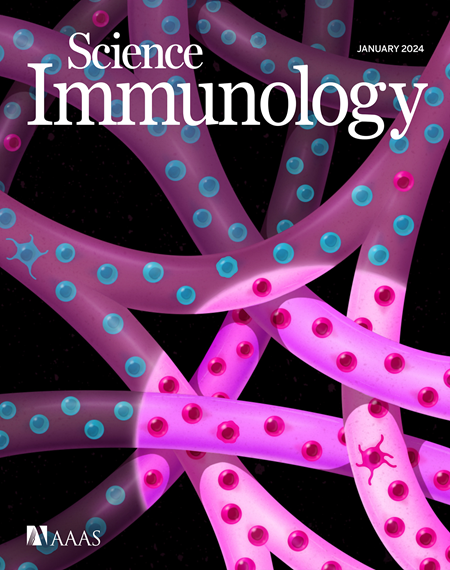单细胞多组学鉴定Tcf1和Lef1是早期胸腺祖细胞命运的关键启动子。
IF 16.3
1区 医学
Q1 IMMUNOLOGY
引用次数: 0
摘要
骨髓来源的多能造血祖细胞在胸腺中形成早期胸腺祖细胞(ETPs)。然而,控制ETP形成的因素仍然不明确。利用单细胞RNA测序(scRNA-seq)和单细胞转座酶可及染色质测序(scATAC-seq),我们剖析了小鼠etp转录组学和染色质可及性景观的异质性。尽管Tcf1- ETPs表现出更高的增殖能力,但Tcf1+ ETPs似乎是T谱系特异性早期胸腺细胞的直接、更强大的前体。胸腺前消融Tcf1及其同源物Lef1严重损害了体内ETP的形成。虽然单独切除Tcf1的影响有限,但Tcf1和Lef1的丢失会破坏Notch1和Notch通路效应分子(包括Hes1和Hhex)的转录激活,并伴有异常诱导的B细胞和髓细胞基因程序。这两个因子的急性缺失会破坏Notch通路、糖酵解和T细胞基因程序。因此,Tcf1和Lef1作用于Notch通路的上游,作为ETP命运的胸腺前启动者和ETP身份和T谱系潜能的胸腺内守门人。本文章由计算机程序翻译,如有差异,请以英文原文为准。
Single-cell multiomics identifies Tcf1 and Lef1 as key initiators of early thymic progenitor fate
Bone marrow–derived multipotent hematopoietic progenitors seed the thymus and generate early thymic progenitors (ETPs). However, the factors governing ETP formation remain poorly defined. Using single-cell RNA sequencing (scRNA-seq) and single-cell assay for transposase-accessible chromatin with sequencing (scATAC-seq), we dissected the heterogeneity of transcriptomic and chromatin accessibility landscapes in murine ETPs. Whereas Tcf1− ETPs exhibited higher proliferative capacity, Tcf1+ ETPs appeared to be immediate, more robust precursors to T lineage–specified early thymocytes. Prethymic ablation of Tcf1 and its homolog Lef1 severely impaired ETP formation in vivo. Whereas ablating Tcf1 alone had limited impact, loss of both Tcf1 and Lef1 impaired transcriptional activation of Notch1 and Notch pathway effector molecules, including Hes1 and Hhex, accompanied by aberrantly induced B cell and myeloid gene programs. Acute deletion of both factors compromised Notch pathway, glycolysis, and T cell gene programs in emergent ETPs ex vivo. Thus, Tcf1 and Lef1 act upstream of the Notch pathway, functioning as prethymic initiators of ETP fate and intrathymic gatekeepers of ETP identity and T lineage potential.
求助全文
通过发布文献求助,成功后即可免费获取论文全文。
去求助
来源期刊

Science Immunology
Immunology and Microbiology-Immunology
CiteScore
32.90
自引率
2.00%
发文量
183
期刊介绍:
Science Immunology is a peer-reviewed journal that publishes original research articles in the field of immunology. The journal encourages the submission of research findings from all areas of immunology, including studies on innate and adaptive immunity, immune cell development and differentiation, immunogenomics, systems immunology, structural immunology, antigen presentation, immunometabolism, and mucosal immunology. Additionally, the journal covers research on immune contributions to health and disease, such as host defense, inflammation, cancer immunology, autoimmunity, allergy, transplantation, and immunodeficiency. Science Immunology maintains the same high-quality standard as other journals in the Science family and aims to facilitate understanding of the immune system by showcasing innovative advances in immunology research from all organisms and model systems, including humans.
 求助内容:
求助内容: 应助结果提醒方式:
应助结果提醒方式:


